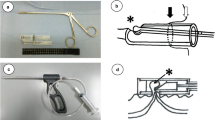Abstract
The purpose is to present the studies of RET gene expression and acetylcholinesterase activity in 23 patients operated for Hirschsprung’s disease (HD). The patients underwent either transanal endorectal pull-through or Duhamell’s procedure. Full-thickness intestinal samples from the three different segments (ganglionic, intermediate and aganglionic) were collected. Each tissue sample was divided in two portions, one for AChE histochemical staining and the other for examination of RET mRNA expression level. All patients had an uneventful postoperative recovery. In all patients, the AChE stainings demonstrated the absence of activity in the ganglionic area, the marked increase of positive fibers in the aganglionic area, and little increase of positive fibers in the intermediate area. In the ganglionic and intermediate areas, all patients (100%) showed significant RET gene expression. In the aganglionic area, 18 patients (78.3%) did not present gene expression and the other five patients (21.7%) presented gene expression that was similar to the ganglionic and intermediate areas. The results reinforce the conclusion that the method of AChE staining is effective for the diagnosis of intestinal aganglionosis and confirm the knowledge that genes beyond RET may be implicated in the genesis of sporadic cases of HD.

Similar content being viewed by others
References
Amiel J, Lyonnet S (2001) Hirschsprung disease associated syndromes, and genetics: a review. J Med Genet 38:729–739. doi:10.1136/jmg.38.11.729
Smigiel R, Patkowski D, Slezak R et al (2004) The role of ret gene in the pathogenesis of Hirschsprung disease. Med Wieku Rozwoj 8:663–675
Romeo G, Ronchetto P, Luo Y et al (1994) Point mutations affecting the tyrosine kinase domain of the ret proto-oncogene in Hirschsprung’s disease. Nature 367:377–378. doi:10.1038/367377a0
Amiel J, Sproat-Emison E, Garcia-Barcelo M et al (2008) Hirschsprung disease, associated syndromes and genetics: a review. J Med Genet 45:1–14. doi:10.1136/jmg.2007.053959
Ishizaka Y, Itoh F, Tahira T et al (1989) Human ret proto-oncogene mapped to chromosome 10q11.2. Oncogene 4:1519–1521
Chen WC, Chang SS, Sy ED et al (2006) A de novo novel mutation of the EDNRB gene in a Taiwanese boy with Hirschsprung disease. J Formos Med Assoc 105:349–354
Brito IA (1987) Evolution with age of the acetylcholinesterase activity in rectal suction biopsy in Hirschsprung’s disease. J Pediatr Surg 22:425–430. doi:10.1016/S0022-3468(87)80262-2
De la Torre-Mondragón L, Ortega-Salgado JA (1998) Transanal endorectal pull-through for Hirschsprung’s disease. J Pediatr Surg 33:1283–1286. doi:10.1016/S0022-3468(98)90169-5
Kusafuka T, Puri P (1997) Altered ret gene mRNA expression in Hirschsprung’s disease. J Pediatr Surg 32:600–604. doi:10.1016/S0022-3468(97)90716-8
Takahashi M, Ritz J, Cooper GM (1985) Activation of novel human transforming gene ret by DNA rearrangement. Cell 42:581–588. doi:10.1016/0092-8674(85)90115-1
Pasini B, Hofstra RM, Yin L et al (1995) The physical map of the RET proto-oncogene. Oncogene 11:1737–1747
Höppener JWM, Lips CJM (1996) Ret receptor tyrosine kinase gene mutations: molecular biological, physiological and clinical aspects. Eur J Clin Invest 26:613–624. doi:10.1111/j.1365-2362.1996.tb02144.x
Tou JF, Li MJ, Guan T et al (2006) Mutation of RET proto-oncogene in Hirschsprung’s disease and intestinal neuronal dysplasia. World J Gastroenterol 12:1136–1139
Shimotake T, Iwai N, Inoue K et al (1997) Germline mutation of RET proto-oncogene in children with total aganglionosis. J Pediatr Surg 32:498–500. doi:10.1016/S0022-3468(97)90615-1
Sancandi M, Ceccherini I, Costa M et al (2000) Incidence of RET mutations in patients with Hirschsprung’s disease. J Pediatr Surg 35:139–143
Avantaggio V, Dathan NA, Grieco M et al (1994) Developmental expression of the RET protooncogene. Cell Growth Differ 5:305–311
Pachnis V, Mankoo B, Constantini F (1993) Expression of the c-RET proto-oncogene during mouse embryogenesis. Development 119:1005–1017
Attie T, Pelet A, Edery P et al (1995) Diversity of RET proto-oncogene in Hirschsprung disease. Hum Mol Genet 4:1381–1386. doi:10.1093/hmg/4.8.1381
Asai N, Jijiwa M, Enomoto A et al (2006) Ret receptor signaling: dysfunction in thyroid cancer and Hirschsprung’s disease. Pathol Int 56:164–172. doi:10.1111/j.1440-1827.2006.01942.x
Martuccielo G, Thompson H, Mazzola C et al (1998) GNDF deficit in Hirschsprung’s disease. J Pediatr Surg 33:99–102. doi:10.1016/S0022-3468(98)90371-2
Treanor JJS, Goodman L, de Sauvage F et al (1996) Characterization of a multicomponent receptor for GNDF. Nature 382:80–83. doi:10.1038/382080a0
Robertson K, Mason I (1997) The GNDF-RET signaling partnership. Trends Genet 13:1–3. doi:10.1016/S0168-9525(96)30113-3
Angrist M, Bolk S, Halushka M et al (1996) Germline mutations in glial cell line-derived neurotrophic factor (GDNF) and Ret in a Hirschsprung disease patient. Nat Genet 14:341–344. doi:10.1038/ng1196-341
Santos MM, Tannuri U, Coelho MC (2008) Study of acetylcholinesterase activity in rectal suction biopsy for diagnosis of intestinal dysganglionoses: 17-year experience of a single center. Pediatr Surg Int 24:715–719. doi:10.1007/s00383-008-2141-9
Acknowledgments
Supported by grants from Fundação de Amparo a Pesquisa do Estado de São Paulo (FAPESP)-07/01333-2-São Paulo, Brazil.
Author information
Authors and Affiliations
Corresponding author
Rights and permissions
About this article
Cite this article
Coelho, M.C.M., Tannuri, U., Benditt, I. et al. Studies of RET gene expression and acetylcholinesterase activity in a series of sporadic Hirschsprung’s disease. Pediatr Surg Int 24, 1017–1021 (2008). https://doi.org/10.1007/s00383-008-2207-8
Accepted:
Published:
Issue Date:
DOI: https://doi.org/10.1007/s00383-008-2207-8



